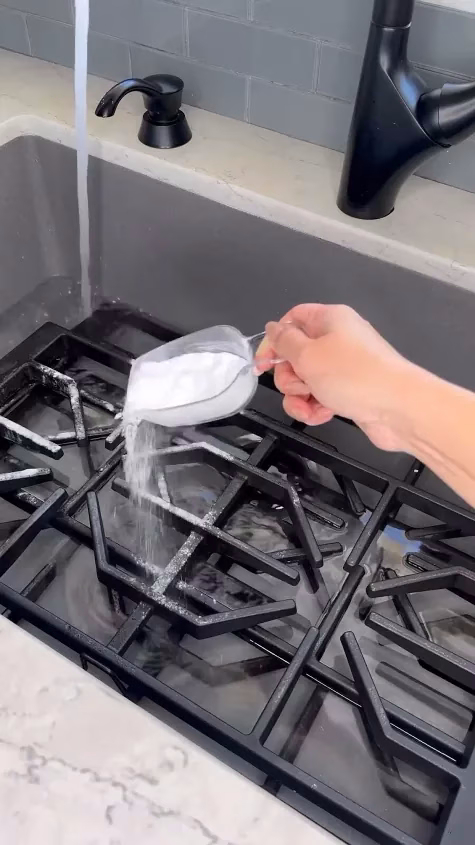ADVERTISEMENT
How to Deep Clean Your Gas Stove in a Few Simple Steps

Each of these items plays a specific role, working in concert to ensure every speck of grime is banished. But what about the cleaning agents themselves? The true power lies in their chemical makeup.
The Essential Cleaning Agents: Unleashing the Power
You don’t need a pantry full of specialized products to achieve spectacular results. Often, the best solutions are simple, effective, and surprisingly eco-friendly:
ADVERTISEMENT
- Dish Soap: Your first line of defense against grease. A good quality, grease-cutting dish soap is crucial for initial breakdown.
- Baking Soda (Bicarbonate of Soda): A mild abrasive, powerful deodorizer, and a fantastic partner for cutting through grease. When mixed with water, it forms a paste that clings to grime, breaking it down over time.
- White Vinegar: An acidic powerhouse that dissolves mineral deposits, cuts through grease, and acts as a natural disinfectant. Its acidic nature is perfect for breaking down tough, alkaline grime.
- Degreaser (Household or Commercial): For truly stubborn, baked-on grease, a dedicated degreaser can be a lifesaver. Look for one that’s safe for kitchen use and always follow product instructions carefully.
- Ammonia (Optional, with Extreme Caution): A highly effective degreaser, but *never* mix with bleach or other cleaners. Use in a very well-ventilated area, preferably outdoors, and only as a last resort for extremely tough jobs. We’ll discuss its specific, contained use later.
- Rubbing Alcohol or Glass Cleaner: Great for a streak-free finish on glass or stainless steel surfaces.
Remember, the magic often happens when these ingredients are allowed to sit and work their wonders. Patience is a virtue in deep cleaning. But before you start mixing and scrubbing, a vital step remains: ensuring your safety and preparing the immediate environment.
Safety First and Setting the Scene: Crucial Preparations
Your safety is paramount. Before touching anything:
- Ensure the Stove is Completely Cool: Hot surfaces can cause burns and make cleaning chemicals less effective or even dangerous. Give it ample time to cool down after use.
- Disconnect the Gas and Electricity: For optimal safety, turn off the gas supply valve to the stove and unplug the appliance from the electrical outlet. If you can’t unplug it, at least turn off the circuit breaker for the kitchen. This prevents accidental ignition and protects electrical components from moisture.
- Ensure Ample Ventilation: Open windows, turn on extractor fans, and create a cross-breeze. This is especially important when using any strong cleaning agents to disperse fumes.
- Clear the Area: Remove all pots, pans, utensils, and anything else from the stove and surrounding countertop. You need clear access to every inch of the stove surface.
-
Lay Down Old Towels or Newspaper: Protect your countertops and floor from spills and drips during the cleaning process.
With your tools assembled, your cleaning agents at the ready, and your safety measures in place, you are now fully equipped for the deep clean. The first frontier awaits: those intimidating grates and burner caps. Many find these the most challenging, but with the right approach, they’ll surrender their grime in no time. Are you ready to witness the astonishing power of a proper soak?
ADVERTISEMENT
Step 1: The First Frontier – Conquering Grates and Burner Caps
Ah, the grates and burner caps – often the most visibly soiled components of your gas stove. They bear the brunt of every spill, every splatter, and every boil-over. Over time, layers of charred food particles and solidified grease fuse onto their surfaces, creating a formidable barrier that can seem impenetrable. Many a cleaner has been defeated by these stubborn adversaries, resorting to half-hearted wipes that merely spread the grime around. But today, we’re not just wiping; we’re launching a full-scale assault designed to lift even the most entrenched deposits.
The key to conquering this first frontier lies in patience and the power of prolonged contact with effective cleaning solutions. Forcing the grime off with brute strength or harsh abrasives can scratch and damage your grates, making future cleaning even harder. Instead, we’ll employ strategies that encourage the grime to release its grip, making the actual scrubbing remarkably easy. Get ready to witness a transformation that will leave you wondering why you didn’t tackle this sooner. The satisfaction of seeing these components return to their original glory is truly unparalleled.
SEE NEXT PAGE
ADVERTISEMENT